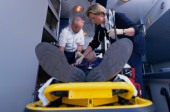
THURSDAY, Dec. 31 (HealthDay News) — Be careful where you walk this New Year’s Eve, particularly if you have been toasting the night away, because researchers say that Jan. 1 is the deadliest day of the year for pedestrians.
A study from the journal Injury Prevention found there are more pedestrians killed on New Year’s Day than any other day of the year. From 1986 to 2002, a total of 410 pedestrians were killed on that date.
In many situations, intoxication — on the part of the walker — plays a role: 58 percent of those killed had been drinking, the study authors noted.
The dangers of driving while intoxicated are well-publicized during the holiday season, but the dangers of walking while intoxicated get little attention, Dr. Thomas Esposito, a trauma surgeon at Loyola University Health System in Maywood, Ill., said in a news release from the school.
“Alcohol impairs your physical ability to walk and to drive,” Esposito said. “It impairs your judgment, reflexes and coordination.”
For Esposito, raising awareness about the dangers to pedestrians is personal. While walking home from a New Year’s party, Esposito’s cousin was killed by a driver believed to be sober.
“His death has had a devastating effect on the family, especially on his parents,” Esposito said. “They required a lot of professional, psychological support and they really have never been the same, especially around the holidays.”
It’s not just during the holidays that alcohol can factor into pedestrian deaths. In 2007, an estimated 37 percent of pedestrians aged 16 and older who were killed had blood alcohol concentrations at or above 0.08 percent, which is the legal definition for drunk driving in most states, according to the Insurance Institute for Highway Safety. More than half of the pedestrians who were killed at night had elevated blood alcohol levels, research shows.
Between July 2008 and June 2009, 86 pedestrians aged 16 and older were treated at Loyola University Health System after being struck by cars, and 14 of the patients had blood alcohol concentrations at or above 0.08 percent.
Esposito’s advice to those who walk outside at night is, don’t put on a black coat and meander along the side of the road. Wear bright clothing, stick to sidewalks and cross at designated crossings. Walk in groups to increase your visibility to drivers and consider walking with a sober pal if you’ve been drinking.
Drivers also need to be aware of the risks of intoxicated pedestrians, especially in areas where there are lots of bars. And if you’re throwing a party, take responsibility for your guests and make sure they don’t walk home drunk.
“You have to be able to assess someone’s perceived ability to safely get from one place to the other,” Esposito stressed. “If their mode of transportation is a car, you do things to prevent them from driving. If that mode of transportation is their legs, then you either drive them or make them stay at home.”
Esposito, who is also a professor of surgery and chief of the division of trauma, surgical critical care and burns at Loyola University Chicago Stritch School of Medicine, said in-home injuries can also be blamed on alcohol consumption.
“All the time we see people who have been drinking that have fallen down the stairs or tripped at home and injured themselves,” Esposito explained. “Others have decided to pick a fight using a knife or with someone holding a gun.”
More information
The U.S. National Highway Traffic Safety Administration has more on pedestrian safety.

